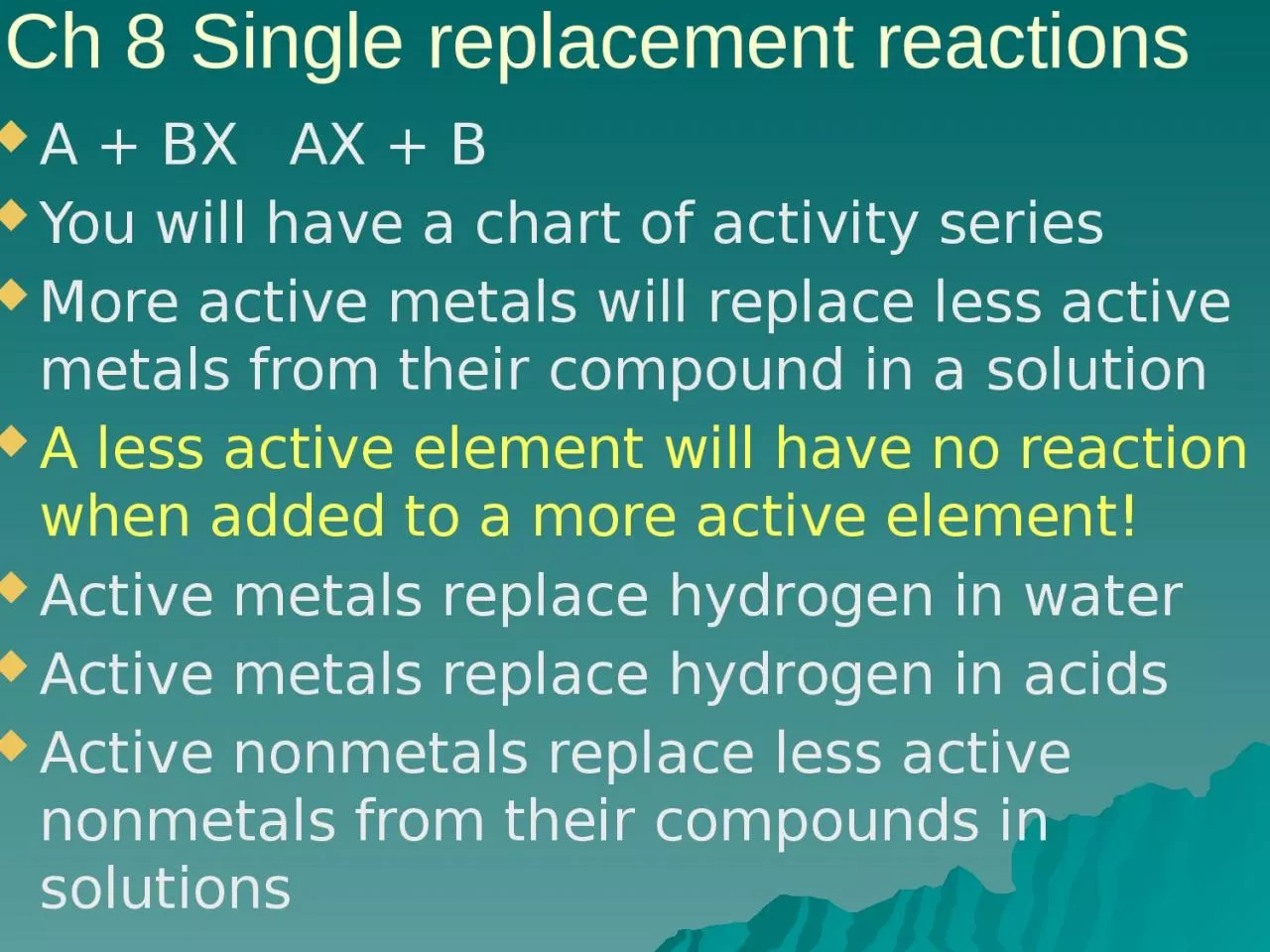

A BX AX B You will have a chart of activity series More active metals will replace less active metals from their compound in a solution A less active element will have no reaction when added to a more active element ID: 1039565
Download Presentation The PPT/PDF document "Ch 8 Single replacement reactions" is the property of its rightful owner. Permission is granted to download and print the materials on this web site for personal, non-commercial use only, and to display it on your personal computer provided you do not modify the materials and that you retain all copyright notices contained in the materials. By downloading content from our website, you accept the terms of this agreement.
1. Ch 8 Single replacement reactionsA + BX AX + BYou will have a chart of activity seriesMore active metals will replace less active metals from their compound in a solutionA less active element will have no reaction when added to a more active element!Active metals replace hydrogen in waterActive metals replace hydrogen in acidsActive nonmetals replace less active nonmetals from their compounds in solutions
2. Activity series chart
3. Old chart from test
4. Using the chartOnly a reaction with a positive E will occurMagnesium reacts with Copper II nitrateThe single replacement would be…Mg + Cu(NO3)2 Mg(NO3)2 +CuBut will this actually occur?Separating to ionsMg + Cu2+ +2 NO3- Mg2+ + 2NO3- +CuIt is easy to see nitrate is a spectator ion
5. From the chartMg Mg2+ + 2 e- E = 2.37V (flipped)Cu2+ + 2 e- Cu E = 0.34 V Ecell = 2.71 VE is positive so the reaction does occurThe net ionic equation of the cell is Mg + Cu2+ Cu + Mg2+
6. ExamplesZinc is added to a solution of cobalt (II) chlorideCadmium is added to a solution of barium iodideLithium is added to a solution of copper (II) chloride forming a precipitateChromium is left in water
7. ExamplesPotassium is added to sulfuric acidSilver is added to hydrochloric acidChlorine gas is bubbled through a solution of sodium bromide
8. Chapter 9 Double replacement reactionsAY + BX AX + BYThese reactions occur in solutionRemember in solution the ions are free floating. For a reaction to occur, the ions have to come together and leave their dissolved state.Formation of a precipitateFormation of a gasFormation of a molecular species
9. Solubility RulesAcids are soluble.Compounds of: alkali metals, ammonium, and nitrate are soluble.This needs to be memorized.
10. Other soluble compoundsAll acetates are soluble except Fe3+All chlorates are soluble. All binary compounds of the halogens (other than F) with metals are soluble, except those of Silver, Mercury(I), and Lead. Fluorides are insoluble except for rule 1 and 2. All sulfates are soluble, except those of barium, strontium, calcium, lead, silver, and mercury (I).
11. Insoluble compoundsCarbonates, oxalates, sulfites, chromates, oxides, silicates, and phosphates are insoluble.Hydroxides are insoluble except Ba, Sr, and Ca Sulfides are insoluble except for calcium, barium, strontium, magnesium. The exception is with alkali metals or ammonium.
12. Ch 10 Net Ionic EquationDetermine what dissolved and precipitatedMg(NO3)2(aq)+Na2CO3(aq) MgCO3(s) + 2NaNO3(aq)Dissociate everything that is aqueous, not solidMg++ + 2NO3- + 2Na+ + CO3-- MgCO3(s) + 2 Na+ + 2NO3-Now cancel out everything that is the same on both sides of the equationThese are called spectator ionsThe remainingpart is the netionic equationMg++ + CO3-- MgCO3(s)
13. ExamplesHydrochloric acid reacts with silver nitratePotassium carbonate reacts with calcium chlorideSodium chloride reacts with ammonium oxalateScandium acetate reacts with lithium chromate
14. GasesH2S (hydrogen sulfide) is formed from any sulfide reacting with an acidCO2 (Carbon dioxide) is formed from any carbonate reacting with an acid, water is also producedSO2 (sulfur dioxide) is formed from any sulfite reacting with an acid, water is also producedNH3 (ammonia) is formed from ammonium reacting with a soluble hydroxide
15. ExamplesAmmonium chloride reacts with calcium hydroxideSodium sulfide is combined with nitric acidAmmonium carbonate is combined with barium chlorateLithium sulfite reacts with phosphoric acid